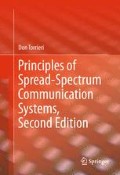Abstract
This chapter reviews fundamental results of coding and modulation theory that are essential to a full understanding of spread-spectrum systems. Channel codes, which are also called error-correction or error-control codes, are vital in fully exploiting the potential capabilities of spread-spectrum communication systems. Although direct-sequence systems greatly suppress interference, practical systems require channel codes to deal with the residual interference and channel impairments such as fading. Frequency-hopping systems are designed to avoid interference, but the possibility of hopping into an unfavorable spectral region usually requires a channel code to maintain adequate performance. In this chapter, coding and modulation theory [1–5] are used to derive the required receiver computations and the error probabilities of the decoded information bits. The emphasis is on the types of codes and modulation that have proved most useful in spread-spectrum systems.
References
W. E. Ryan and S. Lin, Channel Codes: Classical and Modern. Cambridge, UK: Cambridge University Press, 2009.
J. G. Proakis and M. Salehi, Digital Communications, 5th ed. New York: McGraw-Hill, 2008.
T. K. Moon, Error Correction Coding. Hoboken, NJ: Wiley, 2005.
D. R. Barry, E. A. Lee, and D. G. Messerschmitt, Digital Communication, 3rd ed. Boston: Kluwer Academic, 2004.
L. Hanzo, T. H. Liew, and B. L. Yeap, Turbo Coding, Turbo Equalisation and Space-Time Coding. Chichester, UK: Wiley, 2002.
D. Torrieri, “Information-Bit, Information-Symbol, and Decoded-Symbol Error Rates for Linear Block Codes,” IEEE Trans. Commun., vol. 36, pp. 613-617, May 1988.
J.-J. Chang, D.-J. Hwang, and M.-C. Lin, “Some Extended Results on the Search for Good Convolutional Codes,” IEEE Trans. Inform. Theory, vol. 43, pp. 1682–1697, Sept. 1997.
A. Chindapol and J. A. Ritcey, “Design, Analysis and Performance Evaluation for BICM-ID with Square QAM Constellations in Rayleigh Fading Channels,” IEEE J. Select. Areas Commun., vol. 19, pp. 944-957, May 2001.
X. Li, A. Chindapol, and J. A. Ritcey, “Bit-interleaved Coded Modulation with Iterative Decoding and 8PSK Modulation,” IEEE Trans. Commun., vol. 50, pp. 1250-1257, Aug. 2002.
M. C. Valenti and S. Cheng, “Iterative Demodulation and Decoding of Turbo Coded M-ary Noncoherent Orthogonal Modulation,” IEEE J. Select. Areas Commun., vol. 23, pp. 1738–1747, Sept. 2005.
G. Caire, G. Taricco, and E. Biglieri, “Bit-interleaved Coded Modulation,” IEEE Trans. Inform. Theory, vol. 44, pp. 927–946, May 1998.
D. Torrieri and M. C. Valenti, “Constellation Labeling Maps for Low Error Floors,” IEEE Trans. Wireless Commun., vol. 7, pp. 5401-5407, Dec. 2008.
M.C. Valenti and J. Sun, “Turbo codes,” Chapter 12 of Handbook of RF and Wireless Technologies, F. Dowla, ed. New York: Elsevier, Newnes Press, 2004.
IEEE Computer society, “Part 16: Air Interface for Broadband Wireless Access Systems,” IEEE Std. 802.16-2009, http://standards.ieee.org/getieee802/download/802.16-2009.pdf, 2009.
Author information
Authors and Affiliations
Rights and permissions
Copyright information
© 2011 Springer Science+Business Media, LLC
About this chapter
Cite this chapter
Torrieri, D. (2011). Channel Codes and Modulation. In: Principles of Spread-Spectrum Communication Systems. Springer, New York, NY. https://doi.org/10.1007/978-1-4419-9595-7_1
Download citation
DOI: https://doi.org/10.1007/978-1-4419-9595-7_1
Published:
Publisher Name: Springer, New York, NY
Print ISBN: 978-1-4419-9594-0
Online ISBN: 978-1-4419-9595-7
eBook Packages: EngineeringEngineering (R0)

